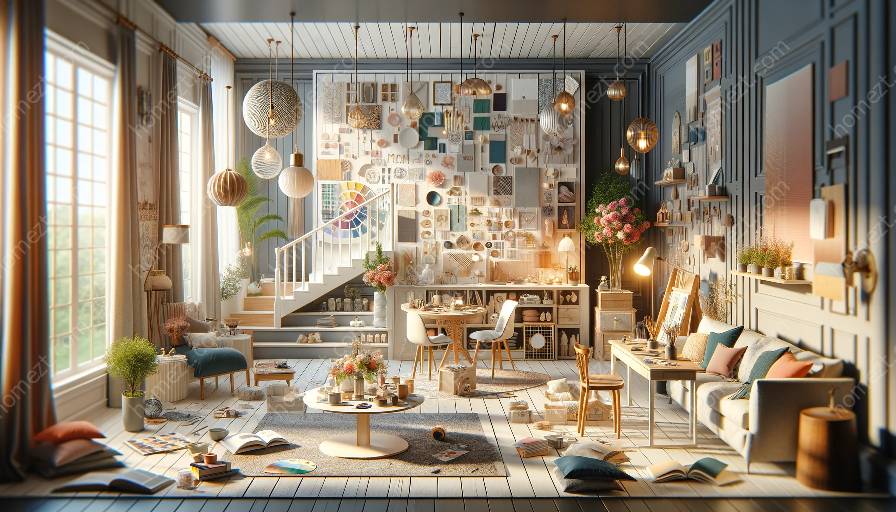Interior design is not just about creating visually appealing spaces but also about considering the psychological impact of the environment on the occupants. Environmental psychology, the study of the relationship between people and their environment, has a significant influence on design concepts in interior spaces. This article will delve into the ways in which environmental psychology can inform and enhance interior design, and how it can be integrated with mood boards and design concepts to create captivating interior spaces.
Understanding Environmental Psychology
Before we discuss the influence of environmental psychology on design concepts in interior spaces, let's first understand what environmental psychology entails. Environmental psychology is the scientific study of how the physical environment affects human behavior and well-being. It explores the interplay between people and their surroundings, encompassing aspects such as perception, cognition, emotions, and social interactions within built environments.
Impact on Interior Design Concepts
Environmental psychology has a profound impact on interior design concepts, as it considers the psychological, emotional, and physiological responses of individuals to their surrounding environment. By incorporating principles from environmental psychology, interior designers can create spaces that promote well-being, productivity, and overall satisfaction for the occupants.
Biophilic Design
One of the key concepts influenced by environmental psychology is biophilic design, which integrates natural elements and patterns into interior spaces to enhance the occupants' connection to nature. Biophilic design has been shown to reduce stress, improve cognitive function, and boost creativity, making it a highly sought-after approach in contemporary interior design.
Color Psychology
Color psychology, another aspect of environmental psychology, plays a crucial role in interior design. Different colors can evoke varied emotional responses, affecting moods, perceptions, and behaviors. Understanding the psychological effects of color enables designers to create harmonious and stimulating environments that cater to the needs and preferences of the occupants.
Environmental Comfort
Considering factors such as lighting, acoustics, and thermal comfort is essential in interior design, as these elements significantly impact the well-being and satisfaction of the users. Environmental psychology provides insights into optimizing these environmental factors to create spaces that are conducive to comfort, concentration, and relaxation.
Integration with Mood Boards and Design Concepts
Mood boards are a visual tool used by designers to convey the intended aesthetic, mood, and style of a design project. By integrating principles of environmental psychology into mood board creation, designers can communicate the intended psychological impact of the design on the occupants. Mood boards can incorporate natural textures, calming color palettes, and elements inspired by nature to evoke positive emotional responses and enhance well-being in the designed spaces.
Design concepts are the fundamental ideas that guide the development of an interior design project. By aligning design concepts with principles of environmental psychology, designers can ensure that the resultant spaces prioritize the psychological comfort and satisfaction of the occupants. This may involve designing spaces that promote relaxation, foster social interactions, or enhance cognitive function based on the specific needs of the users.
Interior Design and Styling
Interior design is a multifaceted discipline that encompasses both the aesthetic and functional aspects of designing interior spaces. By incorporating principles of environmental psychology, designers can elevate the overall experience of the occupants. Styling, which involves the arrangement of furniture, décor, and accessories, can be informed by environmental psychology to create visually pleasing and psychologically supportive environments.
Creating Engaging Experiences
Integrating environmental psychology with interior design and styling enables designers to create engaging experiences that resonate with the users on a psychological level. By curating spaces that cater to the innate human need for connection to nature, social interaction, and sensory stimulation, designers can shape environments that are not only visually appealing but also deeply fulfilling for the occupants.
User-Centered Approach
Environmental psychology encourages a user-centered approach to interior design, emphasizing the importance of understanding the needs, preferences, and behaviors of the occupants. This approach fosters the creation of spaces that are personalized and responsive to the psychological well-being of the users, resulting in environments that are both functional and emotionally enriching.
Sustainable Design Practices
Furthermore, the integration of environmental psychology with interior design and styling can lead to a greater emphasis on sustainable design practices. Considering the environmental impact of materials and the long-term well-being of the users can inform eco-friendly design decisions, contributing to the creation of healthy and environmentally conscious interior spaces.
Conclusion
Environmental psychology offers invaluable insights for interior designers seeking to create spaces that are not only aesthetically pleasing but also psychologically supportive and enriching for the occupants. By integrating principles of environmental psychology with mood boards and design concepts, designers can craft interior spaces that prioritize the well-being, comfort, and satisfaction of the users. This holistic approach to interior design and styling paves the way for the creation of environments that resonate with the innate human need for connection to nature, social interaction, and psychological comfort.


























